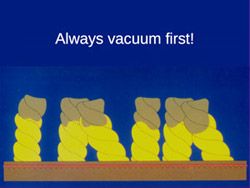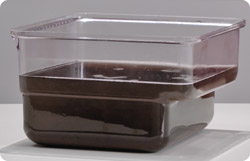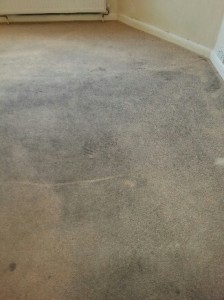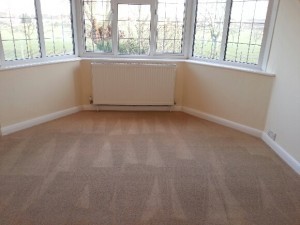Feedback for demo we did a few weeks ago!
We did a demo a few weeks ago for a dry cleaners who where interested in advertising our unique system in a couple of their premises.. the result is that they was so impressed with what they witnessed they have asked that we put some display boards in the shops so we can be recommended to the clients getting dry cleaning…this could be a good outlet for us..priced a nice sisal carpet job today…lady was really nice, booked it in for next week. under pressure from shelley to get my day in the life article finished for next month! will finish it by the weekend i told her….oops
Caring for wool
The purchase of a fine wool carpet/rug is an investment that should be properly cared for. Because wool is a natural fiber, it has different needs than modern synthetic fiber carpets. The dyes used to color wool carpet/rugs are often sensitive to harsh cleaners, so it is important to keep the appropriate cleaners on hand and ensure that harsh chemicals are never used. Wool fibers also have felting properties, making it important that they are handled carefully. A little knowledge goes a long way in caring for wool carpets and rugs and ensuring that your investment will last for years for your family to enjoy.
Regular wool carpet maintenance necessitates vacuuming two to three times a week, dependant on how much foot traffic your carpet sustains. In order to ensure that the maximum amount of dirt is removed from deep in the carpet without hurting the fibers, make sure to set your vacuum’s beater bar at the correct height for your carpet. You want it set as low as possible without slowing the beater bar’s movement. If the beater bar is too low, it will revolve too slowly to be effective, and can tear the tiny fibers of the wool carpet/rug. The strain on a beater bar that is set too low can also burn up the vacuum motor. When vacuuming a wool carpet/rug, be sure to move the vacuum in all directions, vacuuming both the length and width of the carpet. This will help ensure that as much debris as possible is removed.
Vacuuming is standard for all floor coverings. Deeper cleaning methods differ depending on the type of fibers that the carpet is made of. Silk carpets are sensitive to many cleaners that are safe to use on antique wool rugs, and synthetic fiber carpets are the least sensitive of all. It is very important to check with the manufacturer of your rug about what type of cleaning solutions and methods are recommended for that specific rug.
Generally, oxygen based cleaners should never be used on wool fiber carpet/rugs. If a spill occurs, blot the area with clean, white towels until no more wetness shows on the towels and the wool rug is as dry as possible. Using white towels is important, as it stops color transfer from the towel to the carpet. It is also important to be careful to blot, not rub. Rubbing at a spill works the mess deeper into the carpet pile and agitates the wool fibers. If the spill is biologically based, for example pet urine, use an organic microsplitter cleaner on the spill spot and allow to dry on its own so that the microsplitter as time to work. It is usually a good idea to call a professional cleaner after such an accident.
You can have a wool carpet/rug professionally steam cleaned, we would advise against this. For best results, have your wool carpets/ rugs cleaned about every 12-18 months by a company that specializes in cleaning, restoring, and caring for your particular type of wool carpet or rug.
How HOST works in your home.
 HOST® Dry Extraction Carpet Cleaner is a soft, natural product that is environmentally responsible and works in much the same way as an ordinary kitchen sponge. Just like you would use a sponge to wipe up a spill, or to wash and absorb dirt from a counter or wall, HOST is used to wash and absorb dirt from your carpet fibers. As with using a kitchen sponge, you want to limit the amount of water you use while cleaning. Think of the carpet pile as a vertical surface, like a wall. If you use too much liquid, it will run down the yarn toward the carpet backing, just as too much liquid runs down a wall. If you allow this dissolved dirt to run down the backing, it can be more difficult to remove and can wick back.
HOST® Dry Extraction Carpet Cleaner is a soft, natural product that is environmentally responsible and works in much the same way as an ordinary kitchen sponge. Just like you would use a sponge to wipe up a spill, or to wash and absorb dirt from a counter or wall, HOST is used to wash and absorb dirt from your carpet fibers. As with using a kitchen sponge, you want to limit the amount of water you use while cleaning. Think of the carpet pile as a vertical surface, like a wall. If you use too much liquid, it will run down the yarn toward the carpet backing, just as too much liquid runs down a wall. If you allow this dissolved dirt to run down the backing, it can be more difficult to remove and can wick back.
Because HOST is a dry carpet cleaning system it carries the liquid ingredients to the carpet fibers in a controlled way. The soft, organic, natural HOST SPONGES contain all the necessary liquid to dissolve and absorb both water based and oil based dirt. It’s moistened with water and a blend of environmentally friendly ingredients. And because HOST is a low moisture cleaning system, when you’re finished cleaning, the carpet is dry and ready to use immediately.
Mechanical action is required to break the oil bond and pull the dirt away from the carpet fibers. Then this loosened dirt must be removed. HOST is formulated to dissolve both types of dirt and then to absorb it. HOST cleaning doesn’t leave a sticky residue to cause rapid resoiling. A trace of SPONGES may remain in the carpet after vacuuming but it is not abrasive or harmful. This trace amount of SPONGES will be removed with subsequent vacuuming. It’s that simple!
Tile & Grout Clean
Over the last few years, we have called on your services for cleaning our carpets at home. The level of cleaning has always been excellent and also the first class service you give from start to finish. It’s a delight to come home as the carpets always smell incredibly fresh. However I must say that you have surpassed yourself with the cleaning of the grout on our kitchen floor. We nearly were contemplating ripping up the tiled floor and replacing it as it looked so shabby. However after your recent visit – it has come up like new – amazing! Thank you again.
What are those black lines around the skirting boards?
One of the most frequently asked carpet cleaning questions I’ve come across. What are those black lines? The answers is as follows -This type of soiling is called Soil filtration or draught marks . Its the airflow contaminants that are trying to pass through a door, the crack in the wall or gaps in floor boards. This contamination is similar to what you find in your air conditioning filter.As the air passes through the edge of the carpet pile, the microscopic soiling is deposited there, (hence the term filtration soiling). This build up occurs over a extended period of time and is not noticed until a build up has occurred.
This type of soiling is very difficult to remove because the soil particles are so fine that they penetrate deep into the carpet pile, sometimes into the backing of the carpet. So even when you remove them from the pile you may still see the stained carpet backing.
Removing this type of soiling requires special cleaning agents to assist in the process.
To help prevent soil filtration, vacuum(with a good vacuum) and wipe the edges of the carpet on a regular basis.
Do-it-yourself carpet cleaning
 After “steam” cleaning your carpet, it feels pretty good to see that tankful of filthy, nasty water. That is…until you realize that the dirty water in your tank is the same as the dirty water left in your wet carpet.
After “steam” cleaning your carpet, it feels pretty good to see that tankful of filthy, nasty water. That is…until you realize that the dirty water in your tank is the same as the dirty water left in your wet carpet.
Is that deep cleaning?
Now consider cleaning your carpet the green and dry way with HOST:
- No wet carpet
- Easy to use
- Environmentally preferred
- Safe for all carpets, even Orientals and sisal
- Removes dust mites, mold and other allergens
- Spots won’t come back
- Carpet stays cleaner longer
- Lifts matted carpet
- Safer for children and pets
Before and After Pics
Before we used the HOST dry extraction carpet cleaning system.
This was dust from a pulled down ceiling.

After this carpet came up better than when it was first laid!
Vacuumed first, then agitated with the freestyle,
Then HOST sponges applied, Brushed in till dirty,
then vacuumed again, this process was repeated 5 times!
What can be found under beds!
A survey of the things people find under their beds turned up some bizarre results, from sweaty socks to sex toys.
And one man looked underneath his bed – to find his wife’s secret girlfriend,
The survey, said people also found dirty plates, guitars and a mouldy Chinese takeaway.
One of the 2,000 adults questioned returned home to find his wife under the covers and a ‘rustling sound’ coming from under the bed. It turned out to be his wife’s girlfriend.
One woman feared a gas leak only to discover the source of the stench came from a pair of her husband’s sweaty football socks left festering for two years.
Another man was helping his mother-in-law move her bed only to find her collection of adult toys.
Over a third of those polled said they only vacuumed under the bed once a year. One in four would be embarrassed if someone looked under their bed.
Our advice: “Your bed is a haven and its surroundings should be clean and clutter-free to aid a good night’s sleep and that includes under your bed.”
Useful information when investing in a rug
There are a few basics you should know about rugs. Once you understand how to identify what makes a rug valuable, you’ll have a greater chance at purchasing a better rug.
Rug fibers usually consist of wool in most mid to upper end rugs. High-end rugs may also have silk. Synthetic fibers such as acrylic, polyester, nylon, and olefin (polypropylene) can be found in more economical rugs. Cotton, sea grass, and sisal rugs are often moderate rugs. Your most stain resistant rugs will contain synthetic fibers, but won’t feel as soft and luxurious. All other natural fiber rugs are susceptible to staining if spots aren’t cleaned immediately.
What do you look for in a rug?
Quality of wool, type of dye, and knots. Simply because a rug is expensive, doesn’t mean it has good dyes or is constructed well. Make sure you know what it is and shop around first. The quality of a wool fiber depends largely on the type of dye used. Fine wool is vegetable dyed with fruits, roots, and plants. Cheaper wools and nylons can be dyed with synthetic dyes. A rug should always be tested for colourfastness by taking a damp white cloth and gently rubbing it into the fiber. If any color transfers on the cloth, the dyes are unstable.
Also look closely at the fiber to check the integrity. Make sure it isn’t unraveling. Very fine wool fibers can often look as soft as silk even to an experienced rug professional.The construction of a rug is also a key factor.
To determine if the rug is handmade, turn it upside down and look at the back. If you cannot see the pattern as clearly as on the face, the rug is not handmade. If the rug passes this first test, look at the fringe. The fringe should be an extension of the yarn inside the rug and should not look like it was sewed on separately. Many rugs that claim to be hand stitched are stitched by hand with a machine. You can expect to pay at least £250 for a small 3×4 hand made rug.
BEWARE of rugs with cloth backings. These rugs have something to hide. The cloth is covering either flaws in a handmade rug or even worse, glue that is holding the backing together. Glued backings have a tendency to get torn when the rug is moved or cleaned.
If you are looking for an alternative to a handmade rug, you might look at a Karastan. These wool rugs closely resemble hand made rugs, are cheaper in price, and rarely have the problems associated with cheaper wool rugs.
If you aren’t ready to invest several thousand pounds in a rug, these will be your best bet.
Ask the right questions. Educate yourself. Good luck in finding your perfect rug.
Is Dry extraction better?
A Dry carpet cleaner is not completely moisture-free, but it is typically a process where foam, powder, granules or absorbent cleaning compounds are spread across the carpet and they absorb the soil.
This highly-absorbent cleaning solution, or compound, will be vacuumed-extracted, requiring about a fifth of the water that is used in steam cleaning or hot water extraction carpet cleaning methods, if done professionally.
Although customer reviews for the Host dry carpet cleaner are difficult to find, they are out there and people who have used this product really seem to feel it does a great job on their carpet.
Actual users give this product a 5 out of 5 stars. Here are some of the things they had to say about the Host dry carpet cleaning kit.
- No wet carpet
- you can walk on the carpet when the cleaner is down and immediately after you have cleaned your carpet.
- Excellent at removing stains and odors one customer wrote: “I’ve used HOST for over 20 years…it’s been great for my carpets.”
- Easy to use
- Cleans natural fiber rugs that you can’t use wet cleaning methods on
- All natural biodegradable ingredients
The few reviews that could be found were all overwhelmingly positive so there seems to be few real disadvantages to using this product though several reviewers did reveal two or three problems.
- The Product is difficult to find
- somewhat messy
- clogs up some vacuum cleaners.
Of the three disadvantages that consumers listed, the most problematic one is the difficulty in finding this product. However, there seems to be plenty of sites that sell the Host dry carpet cleaning kit online and the official Host website does list distributors that handle their product if you type in your post code.
As for the other two disadvantages some reviewers stated that using a wet/dry vac to do the initial vacuuming after using the Host dry carpet cleaner helps prevent clogs in your home vacuum and it does appear that dry carpet cleaning would be less messier than emptying those dirty buckets from traditional carpet cleaning.
So, It seems the answer is a definite YES!!

